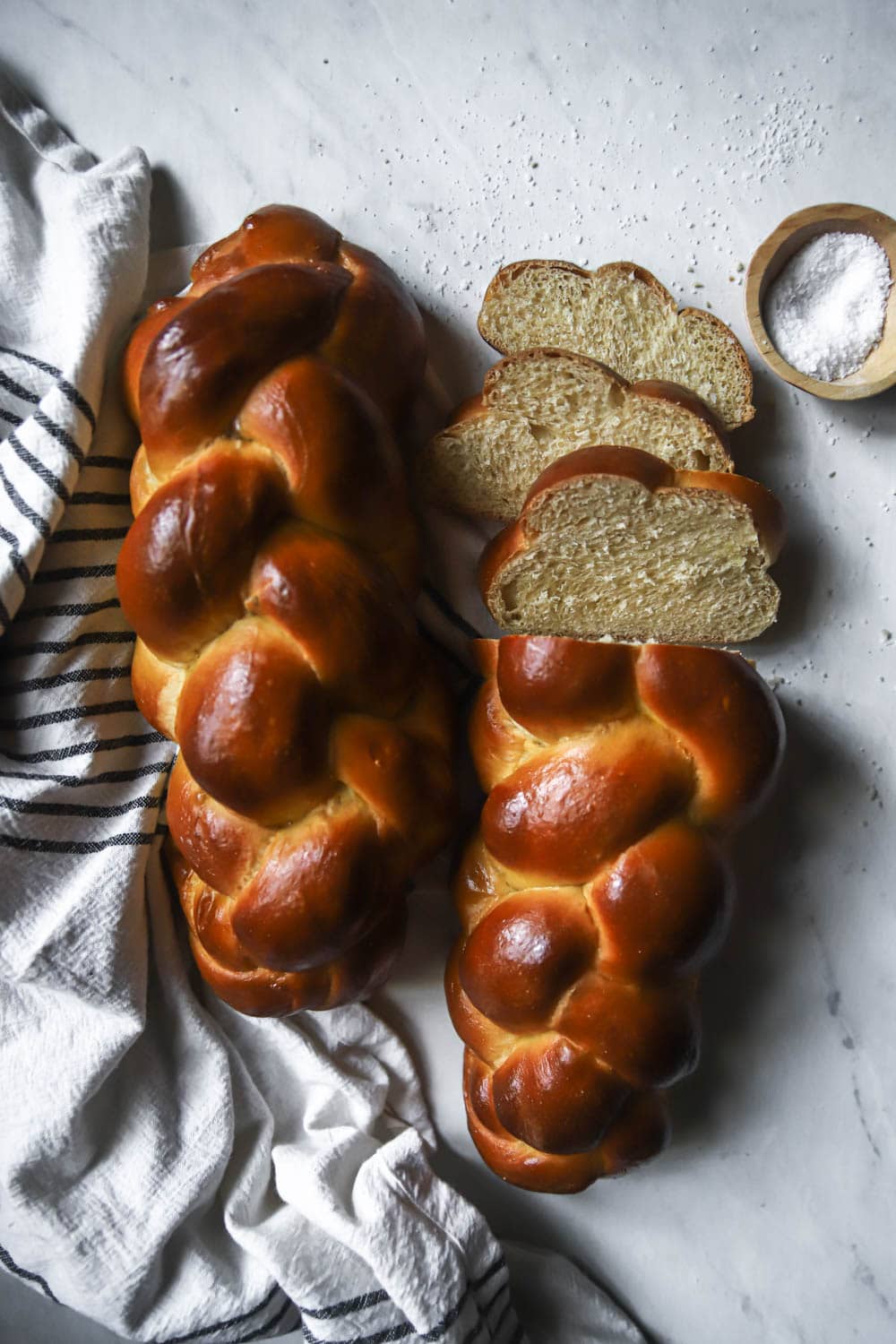
Traditional enriched braided Jewish Challah Bread, 100% naturally leavened with sourdough starter cultures
I am beyond excited to share this Sourdough Challah recipe with you. I’ve been testing this method and recipe for a VERY long time, and I know that you’re going to love one more extremely satisfying loaf of bread that you can make yourself. If you haven’t started your sourdough journey, check out this post to make your very own Sourdough Starter first.
How is sourdough Challah different than yeasted Challah?
One thing people don’t realize is that commercial yeast actually has a very strong flavor of its own, and contributes a lot to the overall flavor of traditional yeasted challah bread. Commercial yeast causes traditional challah to rise very quickly (in about 2.5 hours), and the whole process is done in a few hours. This sourdough version is completely leavened by your active live culture of sourdough. The process is longer, but most of the time you’re passively waiting for the dough to rise. The actual hands-on work is very minimal, and the result is another really satisfying use for your starter.
In terms of flavor, the sourdough version has a very slight tang, but still has the beautiful soft pillowy crumb that we all love in our challahs.
How long does it take to make Sourdough Challah?
This is a two-day process, so plan accordingly. On day one, I feed my starter in the morning. Then, in the evening, I make the stiff levain. A levain is a small in-between step, that feels like making a small bit of dough. It ensures you’ll get a good rise on your bread, but the sourdough tang won’t be overwhelming. One day two, I mix the dough early in the morning, shape and braid the loaves around noon, and bake in the afternoon. Challah has gained huge popularity worldwide, but it is still a traditional Jewish bread, enjoyed on Friday evenings and on holidays. If you observe Shabbat, I would plan to bake the challah on Thursday, so you’re not pressed for time on Friday afternoon.
Is this bread worth the effort?
100% yes. Lately, commercial yeast has been hard to come by. I had gotten so many requests for a sourdough challah recipe, and I have to admit, I was skeptical at first. After tasting the super soft, slightly sweet enriched sourdough loaf, I was hooked. It’s truly incredible how versatile sourdough can be, and I love having the flexibility to make either version. The amount of work is basically the same as regular challah, you’re just waiting for longer stretches of time for the dough to bulk ferment and rise. Sourdough fermentation times are always longer than commercial yeast rising times.
Your baking schedule:
Day 1
9am: feed your sourdough starter
8pm: make your challah levain
Day 2
8am: Mix final challah dough
12pm: Shape the loaves
4-5pm: Bake the challahs
Store any leftovers at room temperature for up to 3 days, or slice and store in the freezer. One of my favorite ways to enjoy leftover challah is by making French toast 🙂
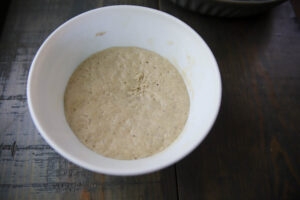
ripe challah levain
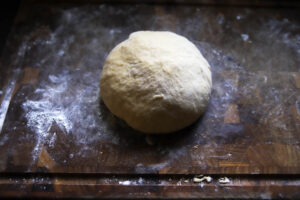
kneaded dough
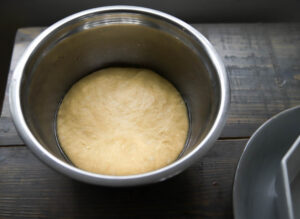
after proof dough
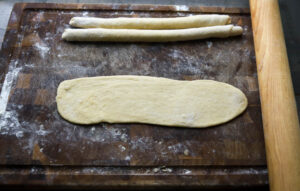
roll out, then roll up
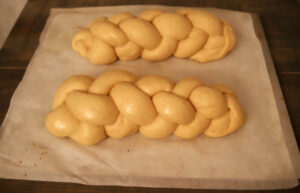
risen dough, pre bake
I cannot wait for you all to try this recipe. Be sure to tap any of the images for the Pin It button to save to your favorite Pinterest boards. I absolutely love seeing these recipes come to life in your kitchens, so please tag me @lions.bread if you make this Sourdough Challah or any recipe from my site, and please reach our via DM or email with any questions that you have.
happy baking – LeAnne
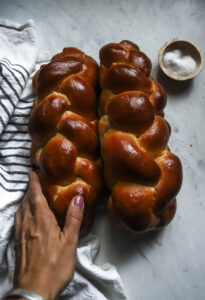
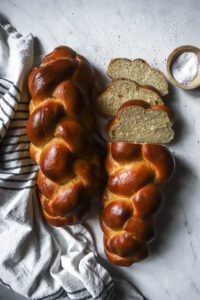
Sourdough Challah
traditional enriched braided Jewish Challah bread, leavened 100% naturally with sourdough starter cultures
Ingredients
Levain
- 45 g ripe sourdough starter refreshed 8-10 hours prior
- 55 g water room temperature, filtered
- 110 g unbleached all purpose flour
Final Challah Dough
- all of the levain
- 65 g warm water, filtered, approx. 90 degrees F
- 2 large eggs, plus 1 egg yolk plus 1 for the egg wash
- 55 g avocado oil, or any neutral oil
- 70 g raw honey
- 10 g kosher salt, I like Morton's
- 50 g whole wheat flour
- 375 g unbleached all purpose flour
Instructions
Make the Levain
This levain is very stiff compared to traditional sourdough levains. In a medium size bowl, combine the ripe sourdough starter and the water. Use a whisk or a Danish dough whisk to break up the sourdough until it dissolves in the water. Add the all purpose flour, and stir until completely combined. Use your hands to knead the dough (in the bowl or on a work surface) until the surface is smooth, about 2-3 minutes. Place the levain in the bowl, and cover tightly with plastic wrap. Allow to ferment 8-12 hours, or overnight, at room temperature. The levain should at least double or even triple in size.
Mix the Final Dough
In a large bowl, combine the warm water and all of the levain. Use your fingers or a Danish dough whisk to break up the levain until it dissolves in the water.
Add the eggs and egg yolk, avocado oil, and honey to the bowl. Whisk to thoroughly combine all of the wet ingredients.
Add the all purpose flour, whole wheat flour, and kosher salt to the bowl. Use a wooden spoon or your hands to incorporate the flours and salt. The dough should be tacky. Move the dough to a lightly floured work surface, and knead by hand for about 10 minutes. The dough may slightly stick to the board as you go, so lightly sprinkle with flour if necessary. You don't want to add much more flour here. Use a bench scraper to scrape the dough off the board, and continue kneading until the dough smooth, and elastic.
Place the dough in a large bowl, and cover with plastic wrap. Allow to rise at room temperature for 3.5 to 4 hours.
Shape the Challah
Pour the dough out onto your lightly floured work surface. Divide the dough in half, and then divide each half into 4 pieces, for a total of 8 equal pieces of dough. If you want to do a 3-strand braid, divide your dough into 6 pieces.
Use a rolling pin to roll each piece of dough out into a long, thin 12" x 3" rectangle, about 1/8" thick. With the long edge facing you, roll the dough up, so it makes a long rope, and pinch the seam closed. Repeat with the remaining pieces of dough.
Line a baking sheet with parchment paper. Take 4 of the ropes, and braid them using your favorite braiding technique. Check out my Instagram for braiding tutorials. Repeat with the remaining 4 ropes of dough. Places the shaped loaves on the prepared baking sheet. Spray a piece of plastic wrap with nonstick cooking spray, and cover the loaves with the plastic wrap, oiled side down. Let proof at room temperature for 5 hours, until the loaves are puffy.
Preheat the oven to 350 degrees F. In a small bowl, beat the remaining egg. Brush the loaves with the beaten egg. When the oven reaches temperature, brush the loaves with the beaten egg again. Leave the loaves plain, or sprinkle with sesame, nigella seeds, pumpkin or poppy seeds. Be creative!
Bake the loaves for 35-40 minutes, rotating the pan halfway through the bake, so the loaves brown evenly. Allow the challahs to cool completely before slicing.
Recipe Notes
- Since this is a lengthy, but simple, process, I usually plan to mix the final dough for the Sourdough Challahs the day before I plan to serve them. Right before serving, I like to reheat them in a 350 degree oven for about 10 minutes.
- Slice any leftover Challah, and either freeze, or make delicious French Toast.
The post Sourdough Challah first appeared on Lion’s Bread Blog.


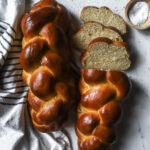
Stephanie says
Hi! I cannot wait to try this recipe. For the starter prior to the levain, what ratio do you use?